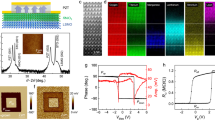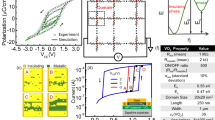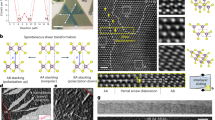Abstract
The primary mechanism of operation of almost all transistors today relies on the electric-field effect in a semiconducting channel to tune its conductivity from the conducting ‘on’ state to a non-conducting ‘off’ state. As transistors continue to scale down to increase computational performance, physical limitations from nanoscale field-effect operation begin to cause undesirable current leakage, which is detrimental to the continued advancement of computing1,2. Using a fundamentally different mechanism of operation, we show that through nanoscale strain engineering with thin films and ferroelectrics the transition metal dichalcogenide MoTe2 can be reversibly switched with electric-field-induced strain between the 1T′-MoTe2 (semimetallic) phase to a semiconducting MoTe2 phase in a field-effect transistor geometry. This alternative mechanism for transistor switching sidesteps all the static and dynamic power consumption problems in conventional field-effect transistors3,4. Using strain, we achieve large non-volatile changes in channel conductivity (Gon/Goff ≈ 107 versus Gon/Goff ≈ 0.04 in the control device) at room temperature. Ferroelectric devices offer the potential to reach sub-nanosecond non-volatile strain switching at the attojoule/bit level5,6,7, with immediate applications in ultrafast low-power non-volatile logic and memory8 while also transforming the landscape of computational architectures because conventional power, speed and volatility considerations for microelectronics may no longer exist.
This is a preview of subscription content, access via your institution
Access options
Access Nature and 54 other Nature Portfolio journals
Get Nature+, our best-value online-access subscription
$29.99 / 30 days
cancel any time
Subscribe to this journal
Receive 12 print issues and online access
$259.00 per year
only $21.58 per issue
Buy this article
- Purchase on Springer Link
- Instant access to full article PDF
Prices may be subject to local taxes which are calculated during checkout




Similar content being viewed by others
Data availability
The data that support the findings of this study are available from the corresponding author upon reasonable request.
References
Zhirnov, V. V. & Cavin, R. K. Nanoelectronics: negative capacitance to the rescue? Nat. Nanotechnol. 3, 77–78 (2008).
Cheung, K. P. On the 60 mV/dec @300 K limit for MOSFET subthreshold swing. In Proceedings of 2010 International Symposium on VLSI Technology, System and Application 72–73 (IEEE, 2010).
Frank, D. J. et al. Device scaling limits of Si MOSFETs and their application dependencies. Proc. IEEE 89, 259–288 (2001).
Pimbley, J. M. & Meindl, J. D. MOSFET scaling limits determined by subthreshold conduction. IEEE Trans. Electron Devices 36, 1711–1721 (1989).
Muller, J., Polakowski, P., Mueller, S. & Mikolajick, T. Ferroelectric hafnium oxide based materials and devices: assessment of current status and future prospects. ECS J. Solid State Sci. Technol. 4, N30–N35 (2015).
Hong, X. Emerging ferroelectric transistors with nanoscale channel materials: the possibilities, the limitations. J. Phys. Condens. Matter 28, 103003 (2016).
Manipatruni, S. et al. Scalable energy-efficient magnetoelectric spin–orbit logic. Nature 565, 35–42 (2019).
Chen, A. A review of emerging non-volatile memory (NVM) technologies and applications. Solid State Electron. 125, 25–38 (2016).
Lee, M. L., Fitzgerald, E. A., Bulsara, M. T., Currie, M. T. & Lochtefeld, A. Strained Si, SiGe and Ge channels for high-mobility metal-oxide-semiconductor field-effect transistors. J. Appl. Phys. 97, 011101 (2005).
Okino, H., Sakamoto, J. & Yamamoto, T. Cooling-rate-dependence of dielectric constant and domain structures in (1 − x)Pb(Mg1/3Nb2/3)O3–xPbTiO3 single crystals. Jpn J. Appl. Phys. 44, 7160–7164 (2005).
Genenko, Y. A., Glaum, J. & Hoffmann, M. J. Mechanisms of aging and fatigue in ferroelectrics. Mater. Sci. Eng. B 192, 52–82 (2015).
Arlt, G. & Neumann, H. Internal bias in ferroelectric ceramics: origin and time dependence. Ferroelectrics 87, 109–120 (1988).
Damodaran, A. R., Breckenfeld, E., Chen, Z., Lee, S. & Martin, L. W. Enhancement of ferroelectric Curie temperature in BaTiO3 films via strain-induced defect dipole alignment. Adv. Mater. 26, 6341–6347 (2014).
Buzzi, M. et al. Single domain spin manipulation by electric fields in strain coupled artificial multiferroic nanostructures. Phys. Rev. Lett. 111, 027204 (2013).
Du, H., Xue, T., Xu, C., Kang, Y. & Dou, W. Improvement of mechanical properties of graphene/substrate interface via regulation of initial strain through cyclic loading. Opt. Lasers Eng. 110, 356–363 (2018).
Cho, S. et al. Phase patterning for ohmic homojunction contact in MoTe2. Science 349, 625–628 (2015).
Lin, Y.-F. et al. Ambipolar MoTe2 transistors and their applications in logic circuits. Adv. Mater. 26, 3263–3269 (2014).
Qu, D. et al. Carrier-type modulation and mobility improvement of thin MoTe 2. Adv. Mater. 29, 1606433 (2017).
Fathipour, S. et al. Exfoliated multilayer MoTe2 field-effect transistors. Appl. Phys. Lett. 105, 192101 (2014).
Duerloo, K.-A. N., Li, Y., Reed, E. J., Scuseria, G. E. & Heinz, T. F. Structural phase transitions in two-dimensional Mo- and W-dichalcogenide monolayers. Nat. Commun. 5, 4214 (2014).
Song, S. et al. Room temperature semiconductor-metal transition of MoTe2 thin films engineered by strain. Nano Lett. 16, 188–193 (2016).
Wu, T. et al. Domain engineered switchable strain states in ferroelectric (011) [Pb(Mg1/3Nb2/3)O3](1 - x)-[PbTiO3]x (PMN-PT, x ≈ 0.32) single crystals. J. Appl. Phys. 109, 124101 (2011).
Yang, L. et al. Bipolar loop-like non-volatile strain in the (001)-oriented Pb(Mg1/3Nb2/3)O3-PbTiO3 single crystals. Sci. Rep. 4, 4591 (2015).
Pesic, M. et al. Built-in bias generation in anti-ferroelectric stacks: methods and device applications. IEEE J. Electron. Devices Soc. 6, 1019–1025 (2018).
Li, X., Wu, M., Xu, B., Liu, R. & Ouyang, C. Compressive strain induced dynamical stability of monolayer 1T-MX2 (M = Mo, W; X = S, Se). Mater. Res. Express 4, 115018 (2017).
Vermeulen, P. A., Mulder, J., Momand, J. & Kooi, B. J. Strain engineering of van der Waals heterostructures. Nanoscale 10, 1474–1480 (2018).
Wang, R. et al. 2D or not 2D: strain tuning in weakly coupled heterostructures. Adv. Funct. Mater. 28, 1705901 (2018).
Kumar, H., Dong, L. & Shenoy, V. B. Limits of coherency and strain transfer in flexible 2D van der Waals heterostructures: formation of strain solitons and interlayer debonding. Sci. Rep. 6, 21516 (2016).
Zhang, F. et al. Electric-field induced structural transition in vertical MoTe2- and Mo1-xWxTe2-based resistive memories. Nat. Mater. 18, 55–61 (2019).
Kalikka, J. et al. Strain-engineered diffusive atomic switching in two-dimensional crystals. Nat. Commun. 7, 11983 (2016).
Manchanda, P., Sharma, V., Yu, H., Sellmyer, D. J. & Skomski, R. Magnetism of Ta dichalcogenide monolayers tuned by strain and hydrogenation. Appl. Phys. Lett. 107, 032402 (2015).
Xiang, H. et al. Quantum spin Hall insulator phase in monolayer WTe2 by uniaxial strain. AIP Adv. 6, 095005 (2016).
Ge, Y., Wan, W., Yang, F. & Yao, Y. The strain effect on superconductivity in phosphorene: a first-principles prediction. New J. Phys. 17, 035008 (2015).
Acknowledgements
This work made use of the Cornell Center for Materials Research Shared Facilities, which are supported through the NSF MRSEC programme (DMR-1719875). The authors thank D.H. Kelley for the borrowed usage of his MBraun glovebox, as well as A. Nick Vamivakas and A. Mukherjee for discussions and assistance with micro-Raman spectroscopy.
Author information
Authors and Affiliations
Contributions
Device fabrication was performed by W.H., A.S., T.P. and A.A. Device characterization was performed by W.H., A.A. and S.M.W. CAFM was performed by W.H., A.S. and S.M.W. Strain gauge calibration was performed by W.H. and S.M.W. Topographic AFM and optical contrast calibration was performed by T.P. Thin-film stress measurements were performed by C.W., A.A., W.H. and S.M.W. Piezoresponse force microscopy was performed by C.W. Raman spectroscopy was performed by A.A. and S.M.W. Finite-element analysis simulation was performed by H.A. PMN-PT single crystals were provided by M.L. The original experiment conception and project supervision were provided by S.M.W.
Corresponding author
Ethics declarations
Competing interests
The authors declare no competing interests.
Additional information
Journal peer review information: Nature Nanotechnology thanks Young Hee Lee and Robert Simpson for their contribution to the peer review of this work.
Publisher’s note: Springer Nature remains neutral with regard to jurisdictional claims in published maps and institutional affiliations.
Supplementary information
Supplementary Information
Supplementary text and Supplementary Figs. 1–15
Rights and permissions
About this article
Cite this article
Hou, W., Azizimanesh, A., Sewaket, A. et al. Strain-based room-temperature non-volatile MoTe2 ferroelectric phase change transistor. Nat. Nanotechnol. 14, 668–673 (2019). https://doi.org/10.1038/s41565-019-0466-2
Received:
Accepted:
Published:
Issue Date:
DOI: https://doi.org/10.1038/s41565-019-0466-2
This article is cited by
-
Phase-selective in-plane heteroepitaxial growth of H-phase CrSe2
Nature Communications (2024)
-
Intrinsic 1\({T}^{{\prime} }\) phase induced in atomically thin 2H-MoTe2 by a single terahertz pulse
Nature Communications (2023)
-
Strain engineering of vertical molybdenum ditelluride phase-change memristors
Nature Electronics (2023)
-
Recent developments in CVD growth and applications of 2D transition metal dichalcogenides
Frontiers of Physics (2023)
-
Two-dimensional diamonds from sp2-to-sp3 phase transitions
Nature Reviews Materials (2022)



